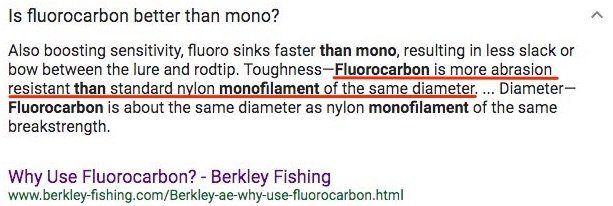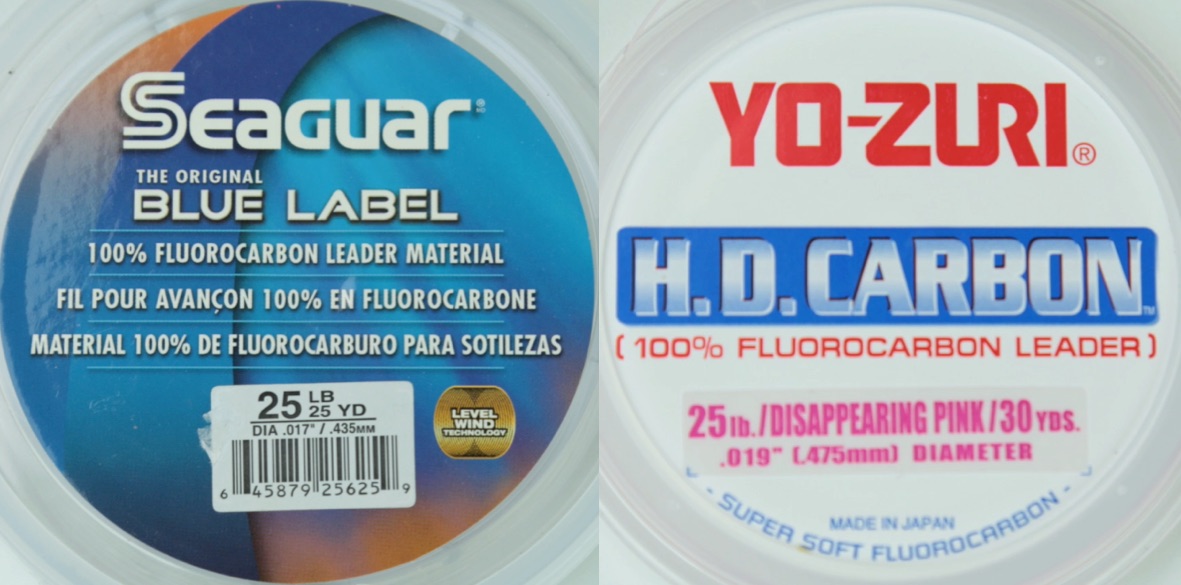Seaguar vs. Yo-Zuri [Fluorocarbon Leader Abrasion Strength Test]
- By: Luke Simonds
- on

It’s line testing time again!
Today, you’ll see the results from a head-to-head abrasion strength test between the two most commonly requested fluorocarbon leaders from the community…
Seaguar Blue Label & Yo-Zuri H.D. Carbon.
Both of these fluorocarbon leaders lines is known for being of high quality and seem to be very popular.
But which fishing line is stronger?
Well, I finally have an answer for you based on the test shown below…
First, here’s the backstory:

Over the past couple of months, I started a quest to determine what the best fishing line is in terms of its true value.
The overall goal of these experiments is to better understand the facts vs. the marketing-induced hype.
We are not affiliated with any line company, and we do not benefit financially if you buy one brand vs. another… or none at all.
This is just a genuine attempt to help us all know which line is truly the best of the best.
So far, some of the results have been very surprising because they completely uncovered some HUGE myths about our beloved fishing line.
Fluorocarbon Leader Strenght Test Overview

Fluorocarbon leader is becoming very popular among saltwater anglers primarily because it’s known for being much less visible to fish relative to traditional monofilament due to its refractive index.
Also, it’s touted as being more abrasion resistant than traditional monofilament.
One of many examples of this claim is shown below from a screenshot of what you’d see when doing some quick online research on the subject:

Given the high costs of fluorocarbon leader relative to traditional monofilament line, it’s important for us to know which leader gives us the best overall value.
Since the invisibility factor of 100% fluorocarbon line is assumed to be constant as explained in this snapshot from a “Fluorocarbon Myths” page on Seaguar’s website:

Source: https://seaguar.com/applications/myths.html
We can go ahead and assume that the visibility difference is a tie between the two lines in this experiment that we’re analyzing head-to-head are equal because they both are 100% fluorocarbon (my assumption is to give the one with slightly thinner diameter a slight advantage).
So this test is going to dive into the abrasion resistance variable which is very important to those of us who target fish that have rough/sharp mouths because they are prone to chewing or biting through our leaders.
Seaguar Fluorocarbon vs. Yo-Zuri Fluorocarbon

Seaguar’s Blue Label and the Yo-Zuri’s H.D. Carbon leader have seemed to be the most commonly requested lines from the community for these tests, so I decided to put them in a head-to-head experiment.
When analyzing two lines in terms of their abrasion resistance, it’s important to note their diameters because all else equal, the line with the thicker diameter is going to hold up to the abrasive resistance best.
And in this case, the Seaguar was thinner so my expectation was that it would break first from the sand-paper test shown below:
- Seaguar Blue Label = .435mm
- Yo-Zuri H.D. Carbon = .475mm
Watch the video below to see what happened:
Click here to see the Fluorocarbon vs. Monofilament test mentioned in this video
Conclusion
From this test, I at least now know that the Seaguar Blue Label line seems to be the better post-hookup performance choice when compared to Yo-Zuri H.D. Carbon due to Seaguar’s line being a thinner diameter while still being able to withstand abrasion from the rough mouths of fish better.
However, the very important visibility factor is still up for debate, and that the factor that I’m sure most anglers consider when opting to use any type of these expensive fluorocarbon lines.
In an effort to see if there truly is a difference in underwater visibility of 100% fluorocarbon lines, I’ll be conducting an underwater test soon with many different lines so that we all can see if there is a difference or not.
So far, these line tests have seemed to continually surprise me as I continue to test more lines. Before starting this, I simply assumed that all lines were essentially equal in terms of strength for their respective weight classes.
But these tests seem to continually prove that these lines are very different from one another.
And that means that more tests like this are needed to determine which one(s) are best suited for our needs.
There will be a lot more testing, so please let me know if you have any suggestions for improving the future experiments.
And let me know what lines you’d like me to try out as well.
Fish On!
P.S. – Please be sure to share this post with any of your friends who use fluorocarbon leaders so that they know their trusted leaders may not be as strong as they thought… this test sure made me reconsider the leaders that I use.
Prior Leader Testing Posts:
- Fluorocarbon Leader vs. Traditional Monofilament Leader [Abrasion Test]
- Is Fluorocarbon Leader Stronger Than Fluorocarbon Main Line? Find Out Here
- Knot Strength Experiment: Blue Label vs Red Label Seaguar Leader Line
See More Fishing Line Tests/Reviews
Related categories:
STOP WASTING TIME ON THE WATER!
Do what the “SMART ANGLERS” are doing and join the Insider Club.
Here’s what you’ll receive today when you join:
- Weekly fishing reports and TRENDS revealing exactly where you should fish every trip
- Weekly “spot dissection” videos that walk you through all the best spots in your area
- Exclusive fishing tips from the PROS you can’t find anywhere else
- Everything you need to start catching fish more consistently (regardless if you fish out of a boat, kayak, or land).









I have regular fluorocarbon fishing line that I am wanting to use for my leader! Is this ok or does it need to say fluorocarbon leader on it? If so what’s the differences. I have Berkley Vanish 20lb. Is this good for leader, or do I need to switch to Seaguar?
So far, I have not seen any fluorocarbon “leaders” that significantly outperform fluorocarbon lines. But I have not tested Berkley Vanish or many of the other less expensive fluoros yet… more tests coming soon.
Thanks luke that was a very informative video. I had been using seaguar for years with great success and I can testify myself that it works wonders. caught my new pb redfish last week on it and it held up even when dragged through an oyster bed!
the red drum was 46 inches and caught on gulp swimming mullet!
Great work on the 46 inch red! They sure are a powerful fish.
Luke have you done any testing with Seaguars Premeir leader? It’s supposed to be better than the blue but who knows?
Not yet, but I did buy a spool of Premier last week and plan to do some tests on it soon.
Good stuff, Luke, as usual. Will be looking forward to your visibility tests. I also commented (half jokingly) on Tony’s wind knot piece that you might want to consider testing different brands of braids for their degree of wind knot avoidance (not sure how you’d manage pulling that off)!
Thanks Gary! I am very much looking forward to the visibility study as well… I’m accumulating a lot of different lines so that we can all see how they compare underwater in various lighting, backgrounds, ets.
As for the wind knot test, that will certainly be a tough one to pull off in a subjective test… I’m testing out different lines right now for casting, so I’ll be sure to take note on any wind knot issues as I do those casting tests.